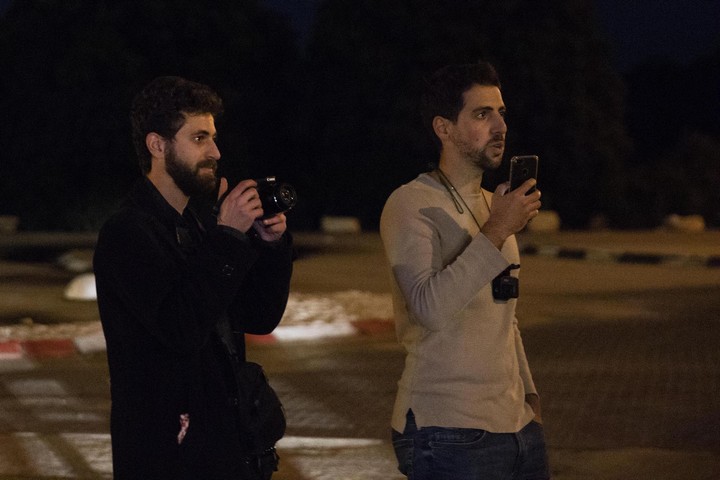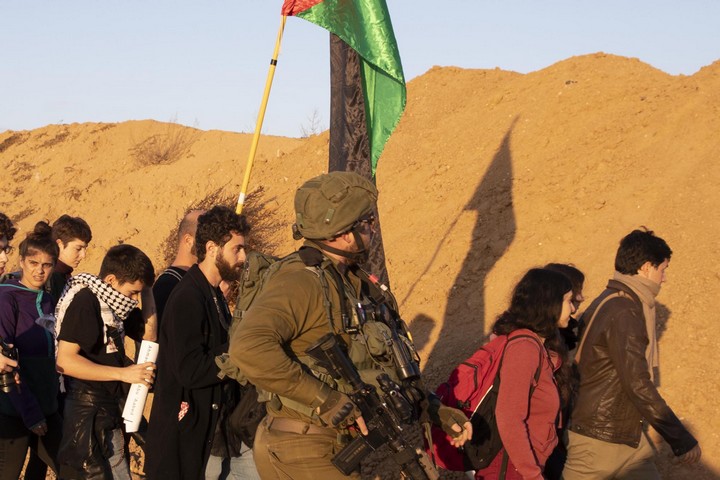Left-wing Israeli activists expose far-right activist who infiltrated a solidarity demonstration at the Israel-Gaza border.

Israeli left-wing activists discovered a right-wing mole who had joined them in a solidarity protest at the Gaza fence last Friday. The protests, in solidarity with Palestinian “Great Return March” protests on the Gaza side of the fence, have been taking place for several months now.
The mole, who has been posing as an anti-occupation activist both online and offline, turned out to be a member of the far-right nationalist group Im Tirzu. In addition to joining the demonstration under false pretenses, the man transmitted information about its timing and location to other Im Tirzu members.
“He asked a lot of questions on the ride [from Jerusalem to the Gaza fence],” said one activist who asked not to be named. “He wanted to know what we do at protests, whether we’ll encounter soldiers, where we are going, and when we’ll get there.”
The mole, who falsely identified himself as Emanuel Brosh, also asked the activists if they think IDF soldiers are deliberately trying to harm children in Gaza. The activists said they are worried he recorded their conversations and would edit them out of context, similar to what happened when far-right moles infiltrated Ta’ayush, a grassroots Palestinian-Israeli organization, in 2015, which led to the political arrest of three of its activists.
On the Gaza side of the fence on Friday, Israeli soldiers killed four Palestinians and wounded dozens more. Wafa News Agency identified the fatalities as Maher Yasin, 40; Abdul-Aziz Abu Shari’a, 28; Ayman Munir Mohammed Shabir, 18; and Mohammad Mo’een Jahjouh, 16.
According to the Palestinian Health Ministry, Shabir was shot in the abdomen east of the Al-Bureij refugee camp while al-Jahjuh was killed after being hit in the neck by a bullet fired by Israeli troops. Abu Shari’a and Yasin died after being shot in separate incidents along the border fence. Four Palestinian paramedics and two journalists were reported to be among the injured.
More than 250 Palestinians have been killed by IDF fire since the protests began. Friday’s fatalities were the first since a ceasefire between Israel and Hamas went into effect in November.
On the Israeli side of the fence, the activists were nearly able to reach the fence near Kibbutz Nir Am, across from the Palestinian village of Khuza’a, where they waved Palestinian flags and chanted slogans against Israel’s siege on Gaza. Israeli soldiers, who were stunned to see Israeli demonstrators so close to the fence, fired warning shots in the air to disperse them, which is extremely rare when dealing with Israeli protesters.
A few minutes minute later, while the soldiers were busy trying to remove the demonstrators, Im Tirzu leader Tom Nissani appeared with a photographer, while the former live-streamed the events on the group’s Facebook page.
After 10 minutes, the soldiers declared the area closed military zone, and the activists returned to their cars and left the area. Many of the activists wondered how Nissani was able to reach the protest so quickly.

Following the protest, activists gathered at a nearby gas station, where they confronted Brosh, who raised suspicions prior to the protest at the fence. The activists accused him of being a mole and demanded to see his phone. Brosh agreed, and the activists said they found a text message exchange with an Im Tirzu activist, in which he gave them the exact location of the protest.
Brosh told the activists, “I am not ashamed of what I do,” and a few minutes later, Nissani showed up and the two eventually left together.
Im Tirzu responded to the incident on its Facebook page, writing that “one of our dear activists was exposed while carrying out important activities as part of an anarchist cell that acts against Israeli soldiers.” According to the Facebook post, the other Im Tirzu activists “quickly arrived, as soon as there was concern that violence would be used against our activist.”
Im Tirzu’s statement, however, does not reflect what happened on the ground. No violence was directed at Brosh by the activists, and his identity was revealed only after the demonstrators had already left the area.
A version of this article of this article was first published in Hebrew on Local Call. Read it here.


